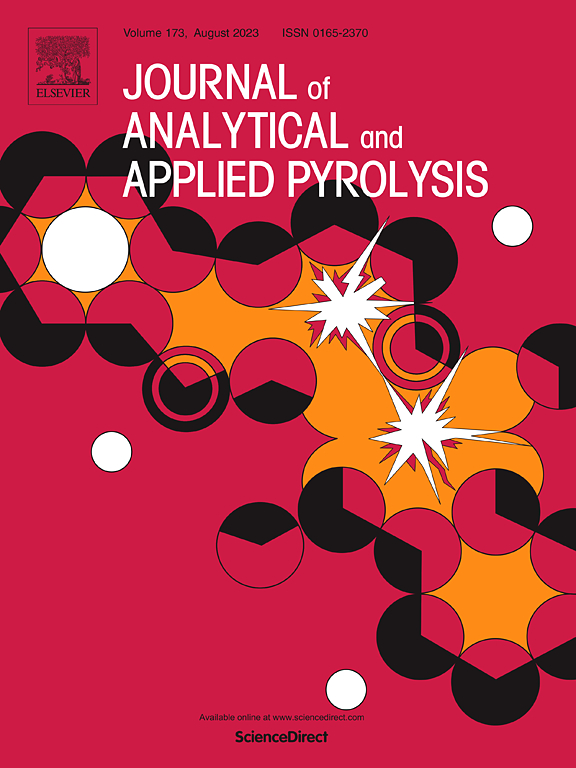通过使用二氧化碳辅助热解啤酒的废谷物的可持续增值,减少酿酒业的二氧化碳排放
IF 5.8
2区 化学
Q1 CHEMISTRY, ANALYTICAL
引用次数: 0
摘要
由于在酿造过程中大量的二氧化碳排放和高能耗,酿造行业面临着重大的环境挑战。为了解决这些问题,本研究提出了一个可持续的平台,以实现啤酒谷物(BSG;(酿造工业的副产品)以减少其碳足迹。在BSG热解过程中利用CO2,以热解气的形式提高能量回收,同时减少碳排放。在最初的热解过程中,CO₂的反应性受到限制,因为在产生大部分bsg衍生挥发物的温度范围内,CO₂的反应性很低。这限制了CO₂增强挥发物热裂解的能力,从而对合成气生产产生不利影响。为了解决这一限制,对装置进行了修改,以提供额外的热能,并纳入催化过程。在催化热解过程中,催化剂的存在显著提高了合成气的产量,实验观察到大量的CO₂消耗。催化热解产生的生物固体用于CO₂捕获。这种双重方法(二氧化碳催化热解和随后使用生物固体吸附二氧化碳)减少了与酿造相关的二氧化碳净排放量。具体而言,生产1 L啤酒的CO₂排放量从非催化热解的202.7 g减少到CO 2催化热解的11.5 g。此外,通过该过程产生的热解气体(H2, CO和CH4)足以满足酿造工业的能源需求。这将减少对化石燃料的依赖。该研究表明,通过共催化热解使BSG增值,为酿酒行业实现碳中和提供了一条可行且经济可行的途径。这种方法通过解决能源回收和碳减排问题,为可持续酿造实践提供了一个模型。本文章由计算机程序翻译,如有差异,请以英文原文为准。
Reducing CO2 emissions in brewing industry through sustainable valorisation of brewer’s spent grain using CO2-assisted pyrolysis
The brewing industry confronts significant environmental challenges owing to the substantial CO₂ emissions and high energy consumption during the brewing process. To address these issues, this study proposes a sustainable platform for valorising spent brewer grain (BSG; a byproduct of the brewing industry) to reduce its carbon footprint. CO2 was utilised in the pyrolysis of BSG to enhance energy recovery in the form of pyrolytic gas while reducing carbon emissions. In the initial pyrolysis setup, the reactivity of CO₂ was limited owing to its low reactivity in the temperature range where most BSG-derived volatiles were generated. This limited the capability of CO₂ to enhance the thermal cracking of volatiles, thereby adversely affecting syngas production. To address this limitation, the setup was modified to provide additional thermal energy and incorporate a catalytic process. During catalytic pyrolysis, the presence of a catalyst significantly enhanced syngas production, and substantial CO₂ consumption was observed experimentally. The biosolid generated from catalytic pyrolysis was utilised for CO₂ capture. This dual approach (CO2-catalysed pyrolysis and subsequent CO2-adsorption using biosolids) reduced the net CO₂ emissions associated with brewing. Specifically, the CO₂ emissions for producing 1 L of beer were reduced from 202.7 g in non-catalytic pyrolysis to 11.5 g in the CO₂-catalysed pyrolysis. Additionally, the pyrolytic gases (H2, CO, and CH4) produced through this process is sufficient to satisfy the energy demands of the brewing industry. This would reduce the reliance on fossil fuels. The study demonstrated that valorising BSG through co-catalysed pyrolysis provides a viable and economically feasible pathway for achieving carbon neutrality in the brewing sector. This approach provides a model for sustainable brewing practices by addressing energy recovery and carbon reduction.
求助全文
通过发布文献求助,成功后即可免费获取论文全文。
去求助
来源期刊
CiteScore
9.10
自引率
11.70%
发文量
340
审稿时长
44 days
期刊介绍:
The Journal of Analytical and Applied Pyrolysis (JAAP) is devoted to the publication of papers dealing with innovative applications of pyrolysis processes, the characterization of products related to pyrolysis reactions, and investigations of reaction mechanism. To be considered by JAAP, a manuscript should present significant progress in these topics. The novelty must be satisfactorily argued in the cover letter. A manuscript with a cover letter to the editor not addressing the novelty is likely to be rejected without review.

 求助内容:
求助内容: 应助结果提醒方式:
应助结果提醒方式:


